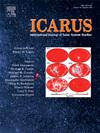谷神星陨坑退化的新模型,包括冰升华和距骨形成
IF 2.5
2区 物理与天体物理
Q2 ASTRONOMY & ASTROPHYSICS
引用次数: 0
摘要
我们报告了广泛发生的talus在洁净的陨石坑墙壁上使用黎明帧相机图像。对于谷神星这样没有大气层的行星体来说,这是出乎意料的,因为陨石坑退化的主要过程被认为是与撞击园艺相关的地形扩散,就像在月球或水星上一样。为了研究为什么talus沉积物如此普遍,以及它们是否与谷神星富含冰的地壳的特殊性质有关,我们在整个谷神星表面绘制了它们的地图,并研究了它们的形态特征。我们将这些特征分为三种不同的类型,以表明它们的保存程度。我们的研究结果表明,距骨总面积(无论其保存程度如何)与纬度或经度之间没有趋势。然而,我们发现,距骨沉积物往往在深而年轻的撞击坑中被观察到,并且某些撞击坑暴露出特别大的距骨沉积物表面积:Dantu, Ninsar, Occator, Kupalo和Juling陨石坑。还注意到,保存完好的距骨比退化程度较重的距骨表面积大,每平方公里固结露头约多20%。根据宿主陨石坑的陨石坑大小频率分布估计的年龄完成了这些观测,给出了保存较完整的talus沉积物的陨石坑的平均年龄为20−4+4 Ma,而保存较退化的陨石坑的平均年龄为280−8+8 Ma。通过对距石矿床的坡度研究,得到了海洋风化层的休止角值:34.5°±2.8°。我们还发现,面向两极的距骨比面向赤道的距骨陡峭约5°,表面积大18%,与面向其他方向的陨石坑壁上的距骨相比,露出地表的数量是其三倍。这表明,构成碎石的物质来源——露头的退化对日晒很敏感。如果我们假设露头是由它们所含的冰凝聚而成的,那么我们可以得出结论,冰的升华导致了它们在距骨物质的起源处破碎。我们认为,在谷神星陨石坑退化的早期阶段,由冰升华引起的露头壁退缩是一个主要的过程,取代了大约数千万年的撞击造园和地形扩散。一旦达到距骨的最大程度,逐渐减少的碎片产生导致距骨活动减少。然后,影响园艺开始起作用,在接下来的几亿年里,talus沉积物慢慢退化,直到完全消失。这对谷神星表面的年龄估计有影响,因为由于冰升华,陨石坑的直径随着时间的推移而变大,导致对年代确定的谷神星区域的年龄略微高估。此外,从谷神星未来任务的角度来看,其目标之一将是精确量化地壳的冰含量,面向两极且尚未退化的露头将是最有趣的探索目标之一。本文章由计算机程序翻译,如有差异,请以英文原文为准。
A new model of crater degradation on Ceres involving ice sublimation and talus formation
We report on the widespread occurence of talus on cerean crater walls using Dawn framing camera images. This is unexpected for a planetary body with no atmosphere like Ceres since the dominant process in crater degradation was expected to be topographic diffusion associated with impact gardening, like on the Moon or Mercury. To investigate why talus deposits are so common, and whether they could be related to the particular nature of Ceres’ ice-rich crust, we mapped them over the entire surface and studied their morphological characteristics. We classified the features into three different types, indicating their degree of preservation. Our results show that there is no trend between the total surface area of talus (whatever their degree of preservation) and latitude or longitude. However, we found that talus deposits tend to be observed within deep and young impact craters, and that certain craters expose a particularly large surface area of talus deposits: Dantu, Ninsar, Occator, Kupalo and Juling craters. It was also noted that well-preserved talus have a larger surface area than more degraded ones, and have 20 % more consolidated outcrops per km. Age estimates from crater size frequency distributions for the host craters completed these observations, giving a mean age of Ma for the craters hosting the more preserved talus deposits, and Ma for the craters hosting the more degraded ones. By studying the slope of the talus deposits, we obtained a value of the angle of repose of the cerean regolith: 34.5° 2.8°. We also found that the talus facing the poles are approximately 5°steeper than those facing the equator, have an 18 % larger surface area, and exhibit three times as many outcrops compared to talus on crater walls facing other directions. This suggests that the degradation of outcrops, the source of the material making up the scree, is sensitive to insolation. If we assume that the outcrops are made cohesive by the ice they contain, then we can conclude that sublimation of this ice leads to their fragmentation, at the origin of the talus material. We suggest that outcrop wall retreat due to ice sublimation feeding talus slopes is a predominant process in the earlier phase of crater degradation on Ceres supplanting impact gardening and topographic diffusion for some tens of million years. Once the maximum extent of the talus is reached, the progressively reduced debris production leads to a decreasing talus activity. Impact gardening then takes over and talus deposits are slowly degraded during the next few hundreds million years before fully disappearing. This has an influence on age estimations of the surface of Ceres, as the diameters of the craters grow larger over time due to the ice sublimation, resulting in a slight overestimation of the age of the dated cerean areas. In addition, in the perspective of future missions to Ceres, one of whose objectives would be to precisely quantify the ice content of the crust, the outcrops facing the poles and not yet degraded would be among the most interesting targets to explore.
求助全文
通过发布文献求助,成功后即可免费获取论文全文。
去求助
来源期刊

Icarus
地学天文-天文与天体物理
CiteScore
6.30
自引率
18.80%
发文量
356
审稿时长
2-4 weeks
期刊介绍:
Icarus is devoted to the publication of original contributions in the field of Solar System studies. Manuscripts reporting the results of new research - observational, experimental, or theoretical - concerning the astronomy, geology, meteorology, physics, chemistry, biology, and other scientific aspects of our Solar System or extrasolar systems are welcome. The journal generally does not publish papers devoted exclusively to the Sun, the Earth, celestial mechanics, meteoritics, or astrophysics. Icarus does not publish papers that provide "improved" versions of Bode''s law, or other numerical relations, without a sound physical basis. Icarus does not publish meeting announcements or general notices. Reviews, historical papers, and manuscripts describing spacecraft instrumentation may be considered, but only with prior approval of the editor. An entire issue of the journal is occasionally devoted to a single subject, usually arising from a conference on the same topic. The language of publication is English. American or British usage is accepted, but not a mixture of these.
 求助内容:
求助内容: 应助结果提醒方式:
应助结果提醒方式:


